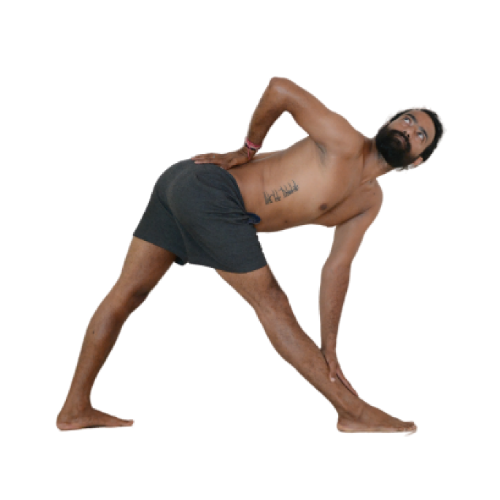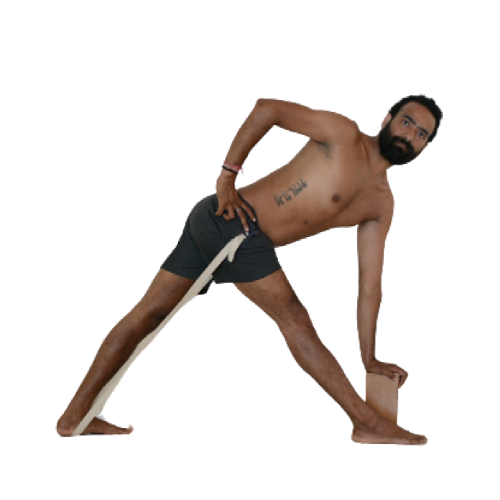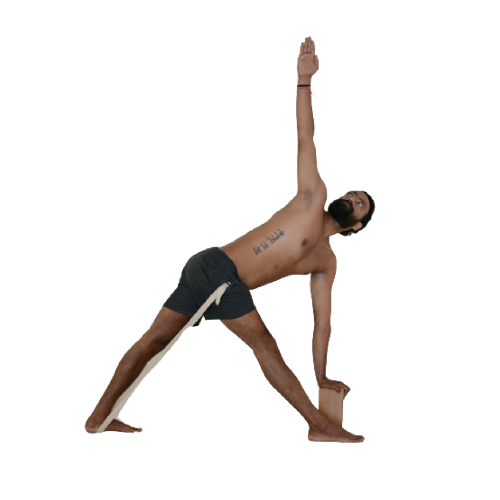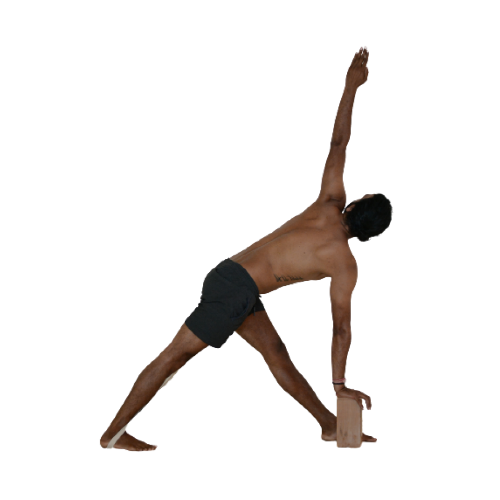From Sanskrit to English
Sanskrit pronunciation: Parivrtta Trikonasana (par-ee-vrit-tah trik-cone-AHS-anna)
Meaning: parivrtta = to revolve, turn around ; trikona = three angles, triangle
Known in English as Revolved Triangle Pose or Twisted Triangle Pose, Parivrtta Trikonasana is – just like all other twists – a cleansing and energizing posture. Used in Ashtanga Vinyasa Yoga as a counterpose to Utthita Trikonasana, its challenging nature provides us with an opportunity to build awareness and work on our ability to be present.
Benefits of Parivrtta Trikonasana
+ Stretches the legs, hips, spine and chest
+ Strengthens the legs, back and core
+ Stimulates the abdominal organs
+ Improves breathing, digestion, and balance
+ Improves flexibility in the legs, shoulders and back
+ Relieves backache and sciatica
+ Therapeutic for constipation, digestive problems, asthma
Yoga for every BODY
The main challenges in Parivrtta Trikonasana include maintaining the back heel to the floor, the squaring of the hips, and the correct alignment of the spine. A good tip would be to break this pose down into two parts; focusing on the feet, hips, and spine before adding the twist. That said, a Standard Parivrtta Trikonasana, as is described below, is only accessible to a few. For this, try out the modifications and perhaps integrate them into your own version of the pose. Keep in mind that what you want to prioritize here is the squaring of your hips and the alignment of your spine. Thus, if you need to adjust the position of your feet and hands to feel more balanced, aligned, and open, please do so.
Standard Parivrtta Trikonasana
1. From Tadasana, step or jump lightly to open your legs about one meter apart (you can find your ideal stance in standard instructions for Utthita Trikonasana). Make sure your heels are in line. Turn what will become your front foot, so that it’s parallel to the long edge of your mat. Then turn your back foot in so that it forms a 45 degree angle.
2. Square your hips as much as possible, you want them to be parallel to the short edge of your mat.
3. Press firmly through your feet to engage and extend your legs. Activate your mula bandha and uddiyana bandha, engage your pelvic floor muscles, draw your lower belly in, lengthen your spine, and open your arms to a “T”.
4. Maintaining your hips square, lean forward over your front leg with a flat back, and reach the outside edge of your front foot with the opposite hand. Push into the floor to straighten your arm.
5. As you keep grounding through your feet, place your other hand flat on your sacrum, send your sitting bones back. Then extend your arm towards the sky to complete the twist in the upper back. Your chest should be open and your shoulders and hand should form a single line.
6. Distribute your weight between your front fingertips and your back heel.
7. Gaze up at your top thumb.
Modification: Building the foundation (no props)
This modification focuses on the first phase occurring in Parivrtta Trikonasana. That is to say, the alignment of the hips and spine. Only then, should we start thinking about the twist taking place in the upper back.
A

B

1. Open your legs at about one meter distance. Turn your front foot so that it’s parallel to the longer edge of your mat, and turn your back foot in to form a 45 to 60 degree angle. Then slide your front foot slightly towards the outer edge of your mat so that your feet are on two parallel lanes. This will help you square your hips.
2. Press firmly through your feet to engage and extend your legs. Activate your mula bandha and uddiyana bandha, engage your pelvic floor muscles, draw your lower belly in, lengthen your spine, and open your arms to a “T”.
3. Lean forward over your front leg with a flat back and reach your front shin with your opposite hand. Keep your hips in place with your other hand and look forward (see picture A).
4. Then, to start working on the twist, flatten your hand over your sacrum, open the shoulder of that same arm towards the sky, and send your gaze up (see picture B).
Modification: Using a strap and block
Looping a strap around your hip crease helps sending the sit bone back and squaring the hips. If you cannot yet reach the floor to the outside of your front foot, reaching out for your inner foot, and perhaps using a block for support, will enable you to keep your spine safe. Also, if you feel pressure in your neck, avoid looking up. Look forward instead.
C

1. Open your legs at about one meter distance. Make sure your heels are in line. Turn what will become your front foot, so that it’s parallel to the long edge of your mat. Then turn your back foot in to form a 45 degree angle.
2. Place a strap underneath your back heel and loop it tight at the level of your front hip crease.
3. Place a block to the inner edge of your front foot.
4. Press firmly through your feet to engage and extend your legs. Activate your mula bandha and uddiyana bandha, engage your pelvic floor muscles, draw your lower belly in, lengthen your spine, and open your arms to a “T”.
5. Lean forward over your front leg with a flat back.
6. Reach your inner front foot on the block with your opposite hand and push into it to straighten your arm. Place your other hand onto your front hip crease and look forward (see picture C).
7. Once you master 6, you can attempt completing the twist by sending your arm up to the sky and looking up at your top thumb (see picture D).
D
Front

Back

Interested in becoming a yoga teacher?
Newsletter
Upcoming events and latest blogs